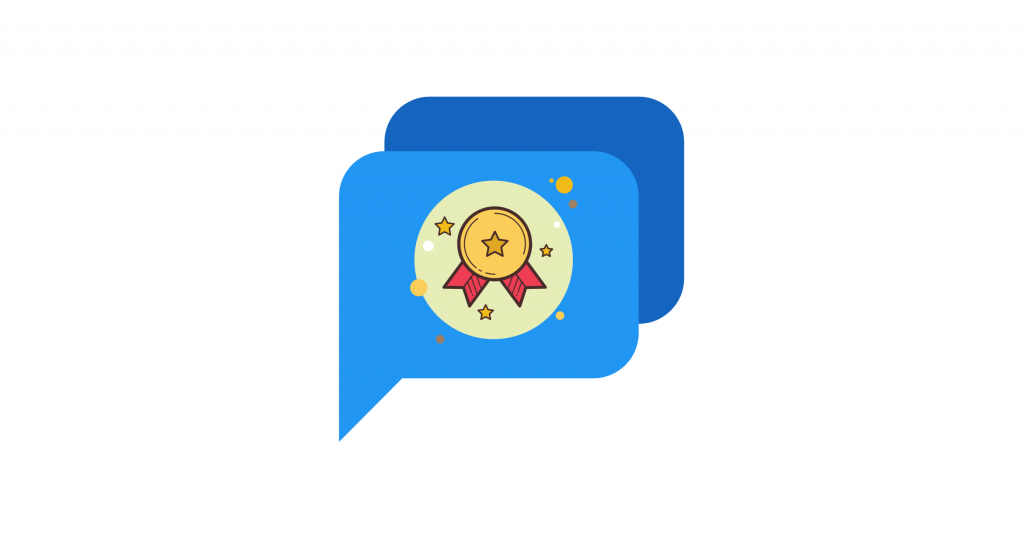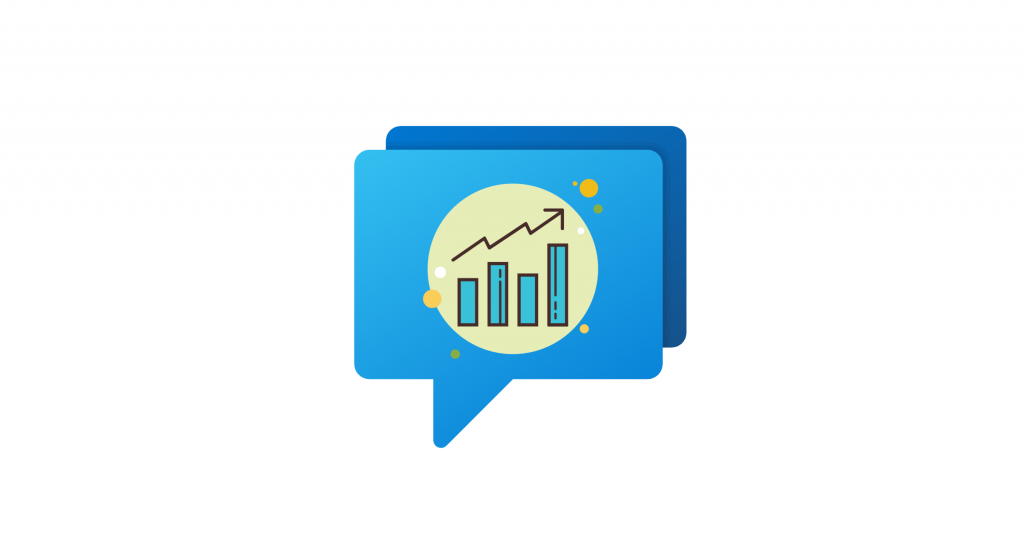Choosing between Drift and Intercom isn't just about picking a chat widget. It's about deciding how your business will connect with customers, where you'll invest your resources, and what kind of experience you're building.
Both platforms have passionate advocates and real results to back them up. But they were built for fundamentally different goals, serve different teams, and come with drastically different price tags. If you're researching "Drift vs Intercom," you're probably trying to figure out which one actually fits your business (or if either one does).
We're going to break down exactly where each platform excels, where they fall short, and help you make a decision that aligns with your actual needs in 2025. No fluff, no vendor spin, just the real comparison you need.
Drift vs Intercom: What's the Main Difference?
Before we get into features and pricing, here's the fundamental distinction that shapes everything else:
Drift is a conversational marketing platform built for sales teams. Its entire purpose is turning website visitors into qualified leads and booked meetings. If you're trying to generate pipeline and close deals through chat, that's Drift's specialty. Research shows that conversational marketing platforms excel at using AI chatbots to qualify leads and schedule meetings automatically.
Intercom is a customer communication suite built for support and product teams. It's designed to help you support existing customers, onboard new users, and engage people throughout their lifecycle with your product. Industry analysis indicates Intercom offers live chat, in-app messaging, help desk functionality, knowledge base tools, and onboarding capabilities all in one platform.
Think of it this way: Drift helps you get customers. Intercom helps you keep them happy.
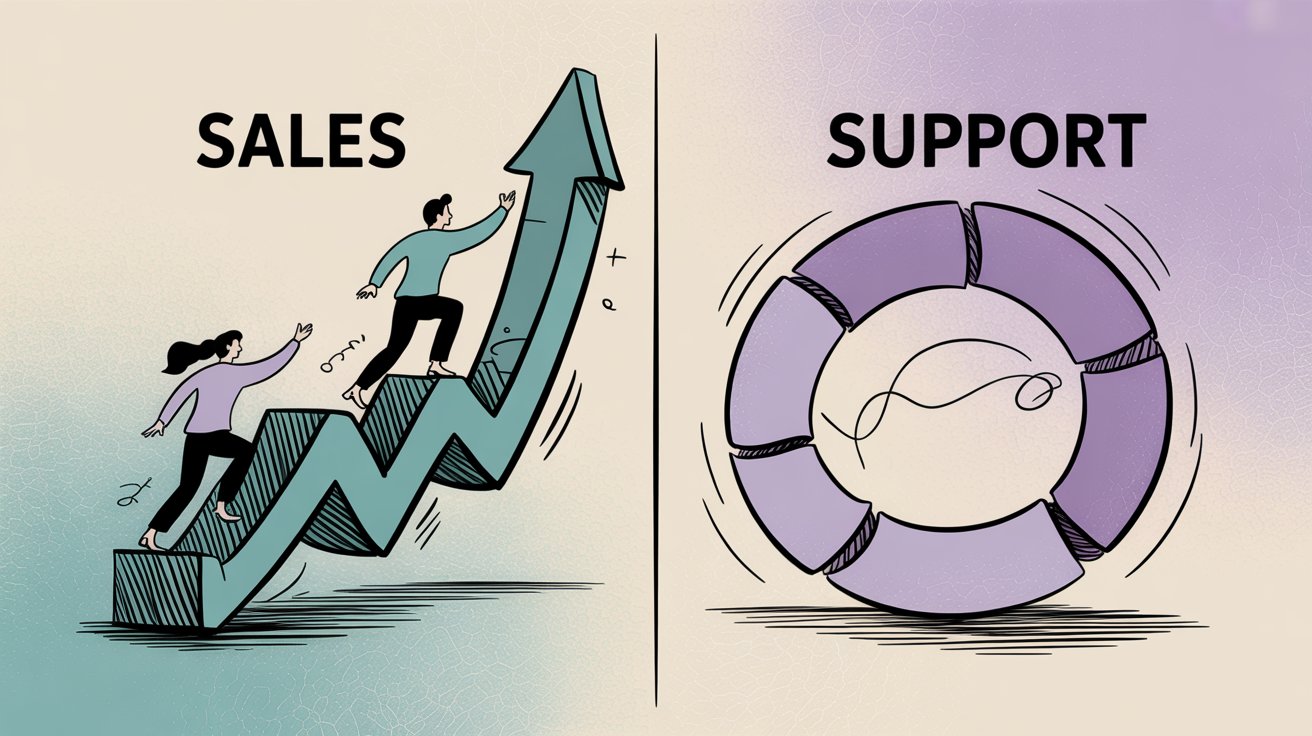
That core difference drives every other aspect of these platforms, from pricing to features to which team members will actually use them. Keep this in mind as we explore each tool in depth.
What Is Drift? Features, Pricing, and Sales Capabilities
Drift (now part of Salesloft) has one mission: turn your website traffic into revenue. Founded in 2015 by David Cancel (former HubSpot executive), Drift pioneered the concept of using live chat specifically as a sales acceleration tool.
In early 2024, Salesloft acquired Drift, signaling an even tighter focus on sales workflows and pipeline generation.
How Drift Works for B2B Sales and Lead Generation
Conversational Lead Capture
Instead of forcing visitors to fill out boring contact forms, Drift starts a conversation. Your AI chatbot can greet visitors, ask qualifying questions, and figure out if they're worth your sales team's time.
For example, a Drift bot might ask:
→ "What's bringing you here today?"
→ "Are you looking for our enterprise or SMB solution?"
→ "How big is your team?"
Based on the answers, the bot can qualify leads and route high-value prospects straight to a human rep or automatically book a meeting on their calendar. Low-quality leads might get directed to resources or a longer nurture sequence.
This means your sales team spends time on qualified opportunities, not tire-kickers.
Account-Based Marketing Features
If you're doing account-based marketing, Drift becomes incredibly powerful. You can create custom experiences for target accounts. When someone from Acme Corp lands on your pricing page, they might see a personalized message: "Hi Acme Corp! Interested in our enterprise plan? Let's talk."
This targeting capability lets you treat VIP prospects differently than anonymous traffic. For companies pursuing specific high-value clients, this kind of personalization can significantly improve conversion rates.
Instant Meeting Scheduling
One of Drift's killer features is eliminating the back-and-forth of scheduling. When a qualified lead is chatting, your sales rep can send a calendar invite right there in the conversation. Or the bot can present available time slots and let the prospect book a demo in real time.
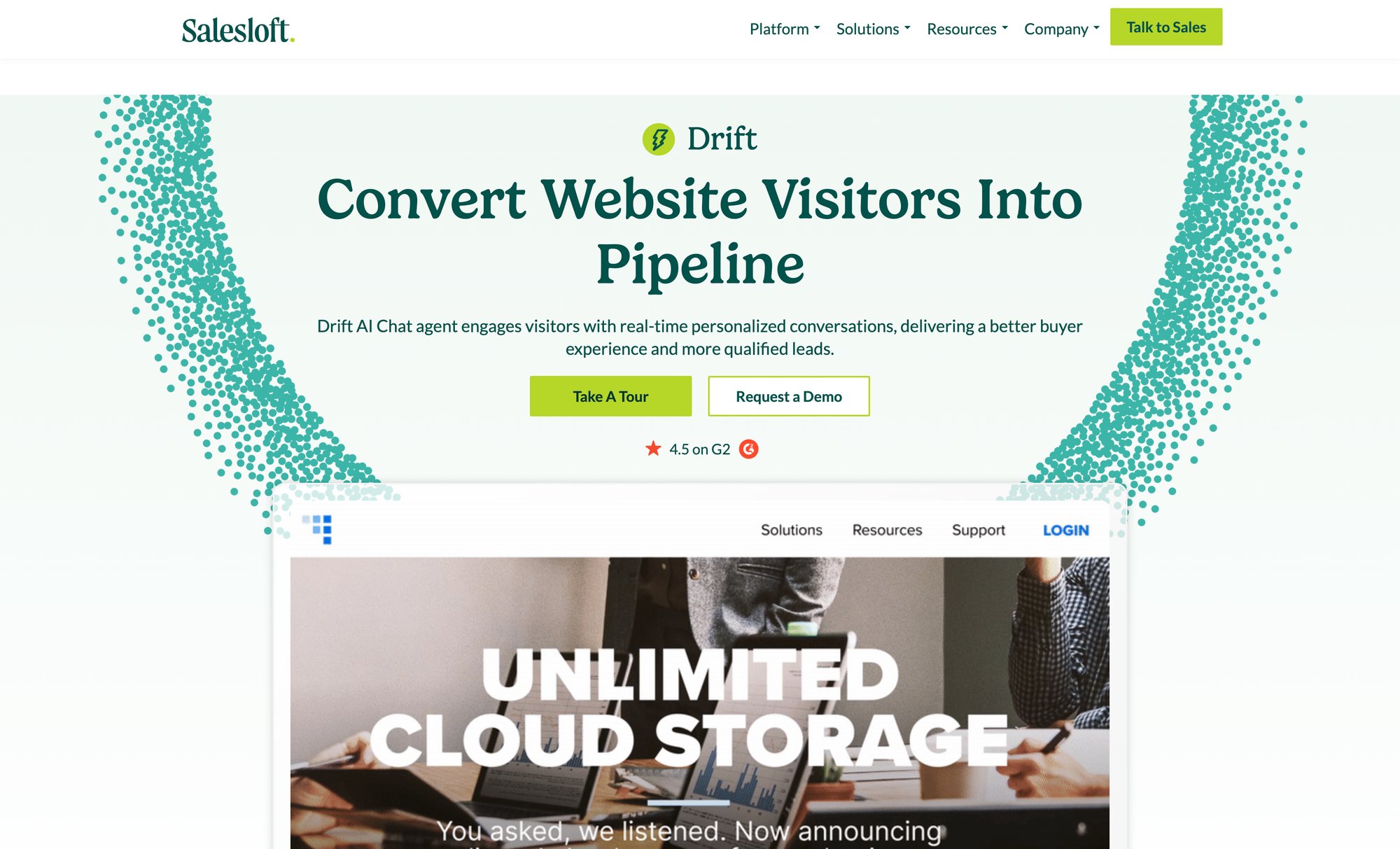
Going from chat to confirmed video meeting in one smooth flow removes a major friction point in the sales process.
Sales-Focused Automation
Drift's "playbooks" let you create custom chat flows triggered by specific behaviors. Maybe you show a proactive chat offering help when someone spends 60 seconds on your pricing page. Or you trigger a different message for visitors coming from a specific campaign.
The automation is all geared toward moving prospects through your funnel. It's not about answering support questions (more on that limitation later).
CRM Integration That Actually Works
Since Drift is built for sales, it integrates deeply with CRMs like Salesforce and HubSpot. Chat transcripts, lead data, and meeting bookings sync automatically. Your sales team sees every interaction in their CRM, ensuring nothing falls through the cracks.
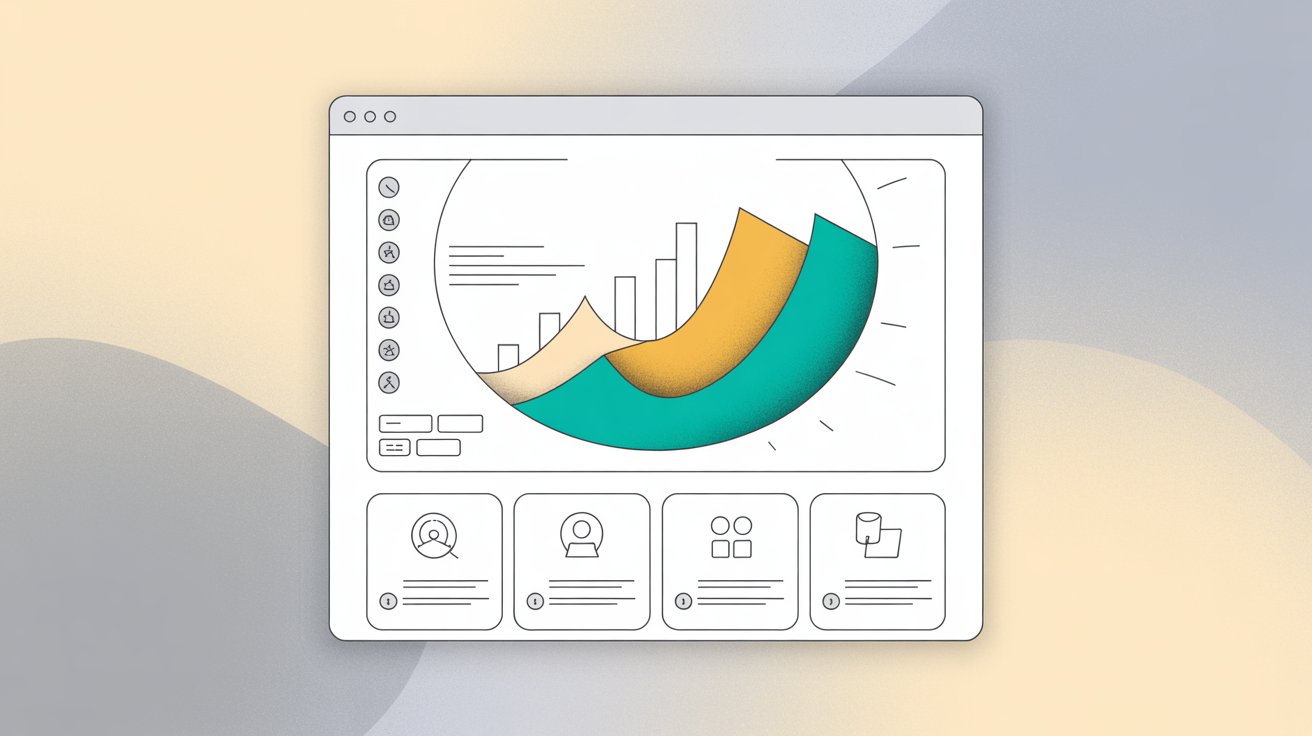
Drift Limitations: What It Doesn't Do Well
No Real Support Capabilities
Drift has no built-in helpdesk or ticketing system. If a chat can't solve an issue on the spot, you'll need to hand off to email or another tool. There's also no public-facing knowledge base like Intercom offers.
Drift does have a "Drift Help" feature where you can feed FAQ content to the bot, but customers can't browse articles themselves. It's just not designed for post-sale support.
Pricing That Excludes Most Companies
This is the elephant in the room. Drift's Premium plan starts around $2,500 per month (annual contract). That's $30,000+ per year as your entry point.
Higher tiers (Advanced and Enterprise) require custom quotes and cost significantly more. Users consistently cite Drift's high cost as a major barrier, with some noting it's too expensive to add more people to chat.
Drift makes sense if one closed deal is worth $50k+ to your business. Then spending $30k annually on a tool that generates several extra deals is easy math. But if you're e-commerce with $50 average order values, or a small business watching every dollar, Drift's pricing doesn't work.
Requires Active Sales Team Engagement
To get value from Drift, you need sales reps ready to jump on chats or follow up immediately. The platform assumes you have dedicated sales staff. If you can't staff it properly, prospects hit a bot dead-end or get told "we'll email you," which defeats the whole instant-engagement advantage.
Learning Curve for Advanced Features
Some users report that Drift's interface isn't intuitive out of the box. Setting up complex playbooks or tweaking bot behavior requires training. While Drift provides customer success managers for high-tier customers, smaller customers may feel a gap in support responsiveness.
Is Drift Right for Your Business? Who Should Use It
Drift makes sense if:
① You're primarily focused on B2B sales pipeline growth. SaaS companies looking to book more demos, B2B firms hunting for qualified leads, or any organization where live chat is a revenue channel (not just support).
② You have high-value deals. If customer lifetime value is in the tens of thousands, Drift's cost becomes justifiable. A few extra closed deals per year can pay for the platform many times over.
③ You have a dedicated sales team ready to engage. SDRs or account executives who can live-answer chats or jump on scheduled calls immediately.
④ You're mid-to-large business with the budget. Drift intentionally prices itself for companies that expect strong ROI from big wins.
Drift is not for you if you primarily need customer support, have a tight budget, or aren't set up to handle high-velocity sales conversations.
What Is Intercom? Features, Pricing, and Support Capabilities
Intercom has been around since 2011 and is often credited with popularizing the chat bubble inside web applications for customer communication.
What started as a simple chat widget has evolved into a comprehensive platform that handles support, onboarding, product messaging, and customer engagement all in one place.
How Intercom Works for Customer Support and Engagement
Complete Support Infrastructure
Intercom's team inbox functions like a helpdesk ticketing system. All customer conversations land there, and your agents can assign, tag, prioritize, snooze, and collaborate on them. The system includes everything you need to manage support workflows without adding another tool.
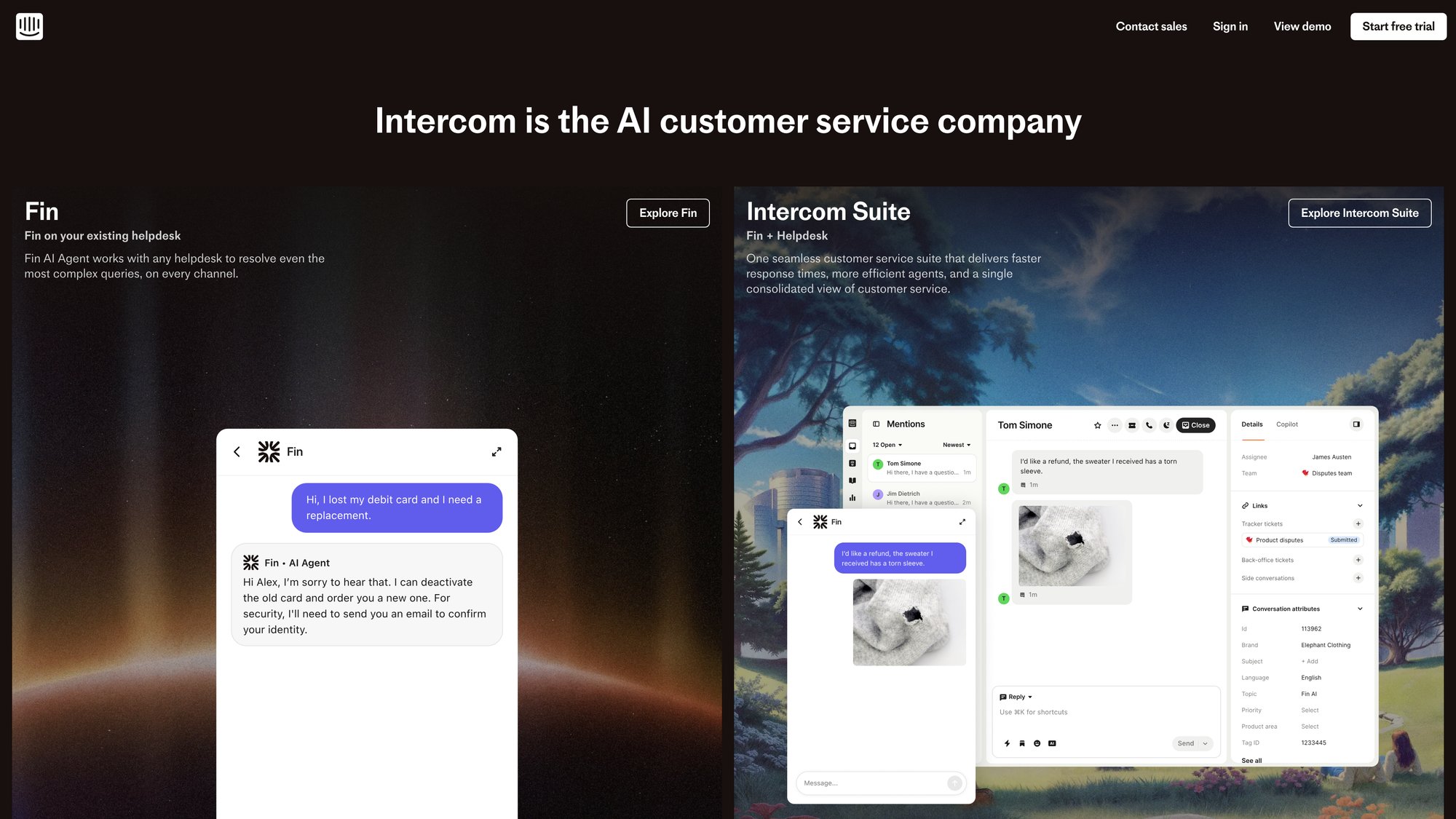
For many small-to-mid teams, Intercom completely replaces email support and standalone helpdesks.
Built-In Knowledge Base
Intercom's Articles module lets you create a full help center with FAQs, guides, categories, and search functionality. Users can access these articles directly from the chat widget or via a public URL.
The real power comes when you connect this to automation. Your chatbot can suggest relevant articles to answer common questions automatically. If someone asks "How do I reset my password?", the bot can instantly surface the right article without requiring human intervention.
This self-service capability can deflect a huge percentage of repetitive support requests.
In-App Messaging and Product Tours
Unlike Drift (which lives on your marketing site), Intercom excels inside your product. The chat widget can be embedded in your SaaS application, letting users reach support without leaving what they're doing.
You can also send proactive in-app messages to guide users: onboarding sequences for new customers, tooltips highlighting new features, or surveys to gather feedback. Intercom's Product Tours (an add-on) let you create step-by-step walkthroughs.
This makes Intercom valuable for product teams trying to increase adoption and reduce churn.

Multichannel Communication
Intercom supports live chat, email, push notifications, and recently added WhatsApp, SMS, and other channels. All these conversations funnel into one unified inbox, so your team isn't switching between tools.
You can start a conversation via website chat, continue it through email, and bring it back to in-app messaging. It's true omnichannel support.
Advanced AI Capabilities
Intercom has gone all-in on AI with two main products:
Fin is an AI chatbot powered by GPT-4 that's trained on your knowledge base. It can handle customer questions in natural language and only charges $0.99 per successful resolution. This pay-for-performance model is appealing, though complex queries can still stump it.
Copilot is an AI assistant for your human agents, suggesting reply drafts and summarizing conversations for $35 per seat.
These AI tools help support teams handle higher volumes without proportionally scaling headcount. If you're interested in similar AI-powered automation, Social Intents offers ChatGPT chatbot integration that can be trained on your content with seamless handoff to human agents.
Intercom Limitations: What to Watch Out For
Pricing Complexity and Expense
Intercom's pricing is notoriously complicated. You pay per seat, plus you might pay based on active contacts, plus add-ons like Product Tours or Surveys cost extra, plus Fin AI charges per resolution.
This layered pricing can lead to surprise bills as you grow. What starts as a reasonable $200-300/month can quickly balloon to $1,000+ when you add team members, exceed contact limits, or enable advanced features.
Many startups find that Intercom bills can hit thousands per month once they're using it seriously. While Intercom offers a 95% startup discount for the first year, regular pricing kicks in after that.
Not Optimized for Sales
While Intercom can capture leads on your marketing site, it lacks sales-specific features that Drift has. There's no built-in calendar scheduling for booking meetings directly from chat. Intercom can pipe leads to Salesforce, but it doesn't have the sales sequences or playbooks that Drift was designed around.
If your primary goal is booking demos and generating pipeline, Intercom will feel less purpose-built than Drift.
Interface Can Feel Overwhelming
Intercom has tabs for Contacts, Conversations, Articles, Messages, and more. New users sometimes feel overwhelmed deciding how to configure everything. The platform is powerful, but that power comes with complexity.
Support for Intercom Can Be Slow
Ironically, getting support from Intercom can be hit or miss. Users note that response times vary unless you're a large customer. While they have extensive help docs and community forums, white-glove support isn't guaranteed on lower tiers.
Is Intercom Right for Your Business? Who Should Use It
Intercom makes sense if:
① You need comprehensive customer support infrastructure. Live chat + ticketing + knowledge base + email in one platform. Perfect for support teams that want to consolidate tools.
② You're a SaaS or digital product company. Intercom excels at in-app messaging and user engagement throughout the customer lifecycle.
③ You value proactive engagement and onboarding. If guiding users with tours, sending targeted messages, and building relationships over time is important, Intercom delivers.
④ You have budget for a premium support experience. Intercom is an investment. If you can justify the cost through improved customer satisfaction and retention, it's worth it.
Intercom is not for you if you're primarily sales-driven and want to convert website visitors into demos, or if budget constraints make the layered pricing model untenable.
Drift vs Intercom Features: Head-to-Head Comparison
Let's compare how these platforms stack up in key areas:
Live Chat Widgets: Drift vs Intercom User Experience
| Aspect | Drift | Intercom |
|---|---|---|
| Primary use | Engaging anonymous visitors for lead gen | Supporting logged-in users and website visitors |
| Widget style | Proactive with sales rep photos/videos | Polished bubble with help articles integrated |
| Personalization | Shows assigned sales rep for known accounts | Shows user context and conversation history |
| Self-service | Limited (bots can answer but no browsable KB) | Strong (articles searchable from chat) |
Verdict: Both offer modern, customizable chat widgets. Intercom's is better for support (with knowledge base integration), while Drift's is better for engagement and conversion.
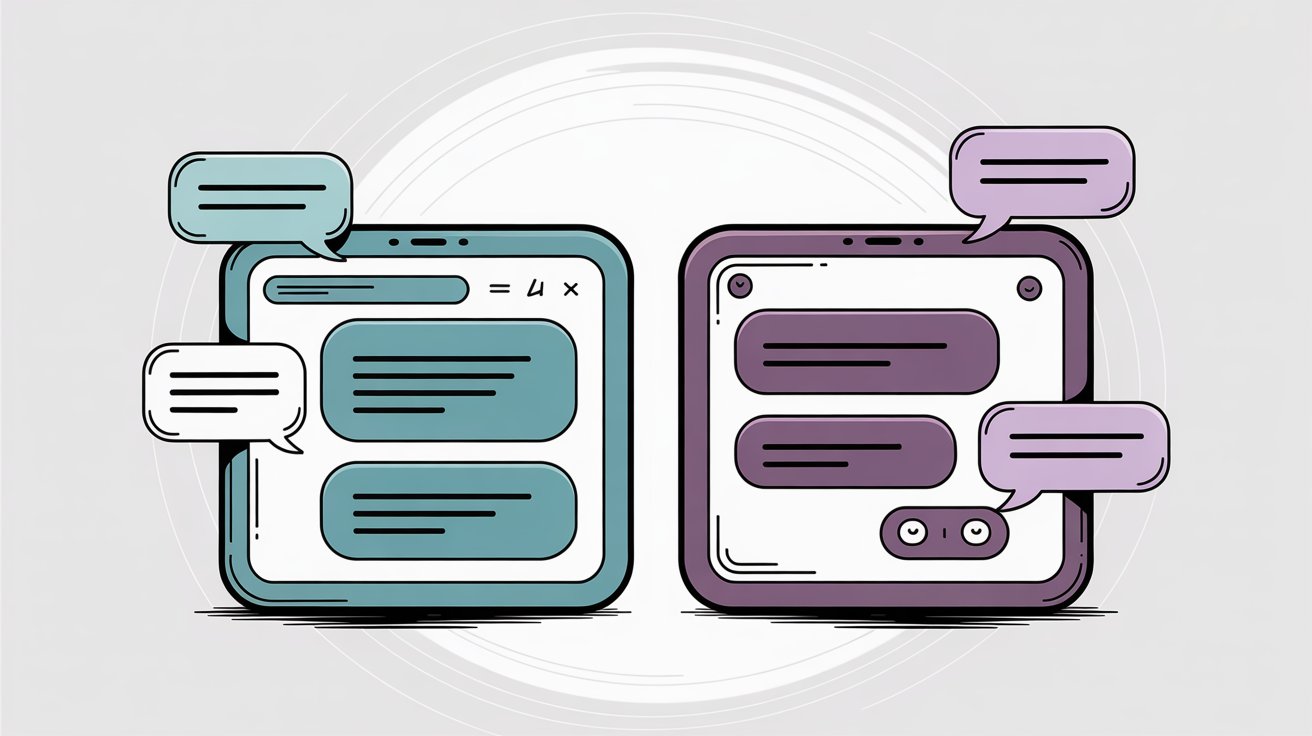
AI Chatbots and Automation: Which Platform Is Better?
Intercom's Bots:
Intercom offers Custom Bots (rule-based flows) and Fin AI Bot (GPT-4 powered). Custom bots can collect info or route conversations ("press 1 for sales, 2 for support"). Fin can answer open-ended questions from your knowledge base in natural language.
The focus is automating support: deflecting common questions, routing to the right team, and reducing agent workload.
Drift's Bots:
Drift's playbook bots are designed for lead qualification. They ask questions, integrate with your CRM to check if the visitor is a target account, and route high-value prospects to humans or schedule meetings.
Drift's bots essentially replace forms with conversational experiences. Instead of a static "Contact Us" form, the bot chats and collects information naturally.
Verdict: For support Q&A automation, Intercom's AI and article integration wins. For lead capture and qualification, Drift's sales-tuned bots are more effective.

Customer Support Ticketing: Drift vs Intercom Helpdesk Features
| Feature | Drift | Intercom |
|---|---|---|
| Ticket system | Basic inboxes only | Full team inbox with assignment, SLAs |
| Email integration | Limited | Complete email workflow |
| Case tracking | No | Yes |
| Support metrics | Not available | Response time, resolution time, CSAT |
Verdict: If you need actual helpdesk functionality, Intercom wins decisively. Drift simply wasn't built for this.
Knowledge Base and Self-Service: Drift vs Intercom
| Feature | Drift | Intercom |
|---|---|---|
| Public help center | No | Yes (full-featured) |
| Article management | Internal Q&A only | Categories, search, rich content |
| Bot integration | Limited (Drift Help) | Deep integration with Fin AI |
| Self-service | Not available | Strong |
Verdict: Intercom provides self-service; Drift doesn't.
CRM and Third-Party Integrations: Drift vs Intercom
| Category | Drift | Intercom |
|---|---|---|
| CRM | Deep (Salesforce, HubSpot, Dynamics) | Deep (Salesforce, HubSpot, Pipedrive, etc.) |
| Marketing | Good (Marketo, Pardot) | Good (Marketo, Mailchimp, etc.) |
| Productivity | Calendar/Zoom for meetings | Slack, Jira, Asana, many more |
| Total ecosystem | Dozens of integrations | 300+ apps in marketplace |
Verdict: Intercom has a richer ecosystem overall. Drift focuses on sales/marketing tools and does those well.
If you're looking for deep CRM integration capabilities, Social Intents connects with Salesforce, HubSpot, and many other platforms through Zapier, while also offering native chat integration with collaboration tools your team already uses.
Analytics and Reporting: Drift vs Intercom Metrics
Intercom:
Support metrics (volume, response time, resolution time, CSAT), engagement metrics (message conversion rates), article views.
Drift:
Sales metrics (meetings booked, leads qualified, pipeline influenced, speed-to-lead).
Verdict: Each platform reports on what matters to its target users. Choose based on what KPIs you care about.
Drift vs Intercom Pricing: Which Is More Affordable?
| Platform | Entry Point | Typical Monthly Cost | Pricing Model |
|---|---|---|---|
| Drift | ~$2,500/mo (Premium, annual) | $2,500-$5,000+ | Tier-based with negotiated pricing |
| Intercom | ~$39/seat/mo (Essential) | $300-$1,500+ | Per seat + contacts + add-ons |
Both can get expensive, but in different ways. Drift has a high floor ($30k+/year minimum), while Intercom can creep up as you add seats, contacts, and features.
Drift vs Intercom Reviews: What Users Actually Say
What Users Say About Drift: Pros and Cons
Positive insights:
→ Sales teams love the pipeline impact ("We booked $X in meetings through Drift!")
→ Increased lead engagement and qualification quality
→ Chatbot effectiveness at capturing information
Common complaints:
→ Cost is consistently cited as prohibitive for smaller companies
→ Some technical glitches reported (messages not firing, playbook UI being clunky)
→ Not suitable for support use cases
G2 Rating: ~4.4/5

What Users Say About Intercom: Pros and Cons
Positive insights:
→ Friendly UI and powerful all-in-one capabilities
→ Fin AI getting positive reviews for innovation and pay-per-resolution fairness
→ Messenger feels modern to end-users
Common complaints:
→ Pricing complexity and expense top complaint
→ Some features feel beta or half-baked when first released
→ Can feel heavy/slow occasionally
G2 Rating: ~4.5/5
Both platforms have strong satisfaction scores overall, with cost being the main friction point for each.
Drift vs Intercom: Which Should You Choose?
Here's how to think through this choice systematically:
When to Choose Drift for Your Business
① Your primary metric is sales pipeline from web traffic
If MQLs, demos booked, and pipeline created are what you measure, Drift was built for this.
② You have a dedicated sales team ready to engage
Drift works best with SDRs or AEs who can jump on chats or take scheduled calls immediately.
③ High customer lifetime value justifies the investment
If one deal is worth $50k+, spending $30k/year on Drift is easy math. Just a few extra deals per year pay for it many times over.
④ You're already invested in sales engagement tools
Drift (now part of Salesloft) fits naturally with platforms like Outreach, SalesLoft, or Gong if you're building a modern sales tech stack.
When to Choose Intercom for Your Business
① You need comprehensive support infrastructure
Live chat + ticketing + knowledge base + email in one place. Perfect for consolidating tools.
② You're a product-focused company (especially SaaS)
If in-app messaging, user onboarding, and lifecycle engagement matter, Intercom excels.
③ You have moderate-to-large support needs
Intercom scales well for teams handling high ticket volumes with collaboration and automation features.
④ You value proactive engagement beyond just support
Sending targeted messages, product tours, and building long-term customer relationships is where Intercom shines.
When to Consider Drift and Intercom Alternatives
Neither platform fits your budget or workflow
Both Drift and Intercom are premium solutions. If pricing is a dealbreaker or you need something different, there are other options worth exploring.
Best Drift and Intercom Alternative: Social Intents
Speaking of alternatives, we should mention why we built Social Intents differently.
The philosophy behind Social Intents: Both Drift and Intercom require your team to learn a new interface and work in yet another dashboard. That's a real barrier to adoption. What if your team could answer website chats from tools they already use every day?
That's the core idea behind Social Intents.
How Social Intents Compares to Drift and Intercom
Native Integration with Teams and Slack
We pipe website chats directly into Microsoft Teams or Slack. Your team answers customer questions as easily as replying to a colleague. No new software to learn, no separate dashboard to monitor.
For teams that already live in Teams or Slack all day, this drastically lowers the adoption barrier and speeds up response times. An incoming chat is just another message in your workflow. We also support Google Chat, Zoom, and Webex for teams using those platforms.
Unlimited Agents Without Per-Seat Pricing
Unlike Intercom's per-seat model, we offer unlimited agents starting at $69/month. Want your entire company to be able to jump into chats? Go ahead. No per-seat charges means no penalty for broad access.
This is especially valuable for companies that want sales, support, and product teams all able to engage with customers without multiplying costs.
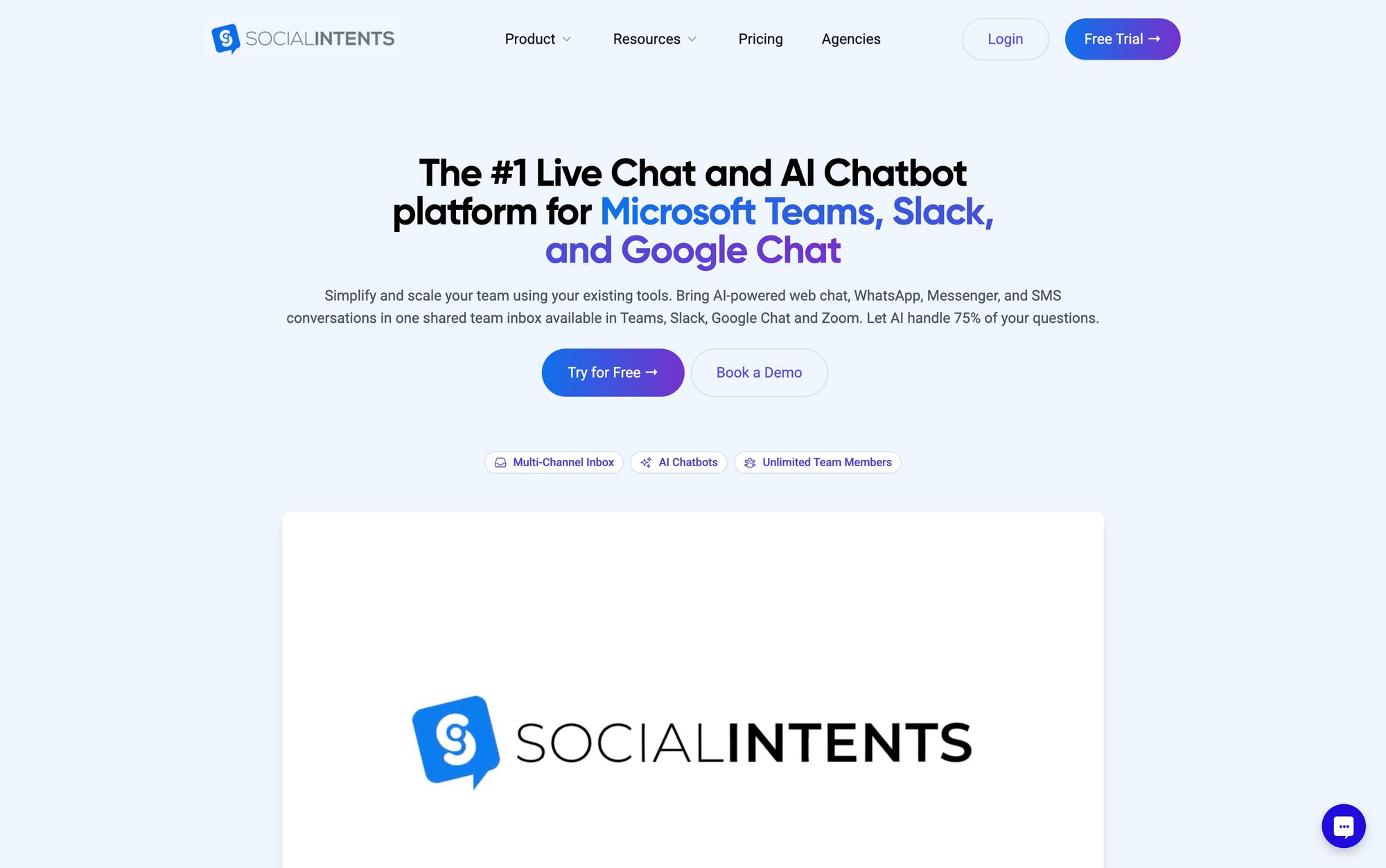
The Social Intents platform puts customer conversations directly into the collaboration tools your team already uses. Instead of monitoring another dashboard, agents receive chat notifications in Teams or Slack channels and can respond instantly from their existing workflow.
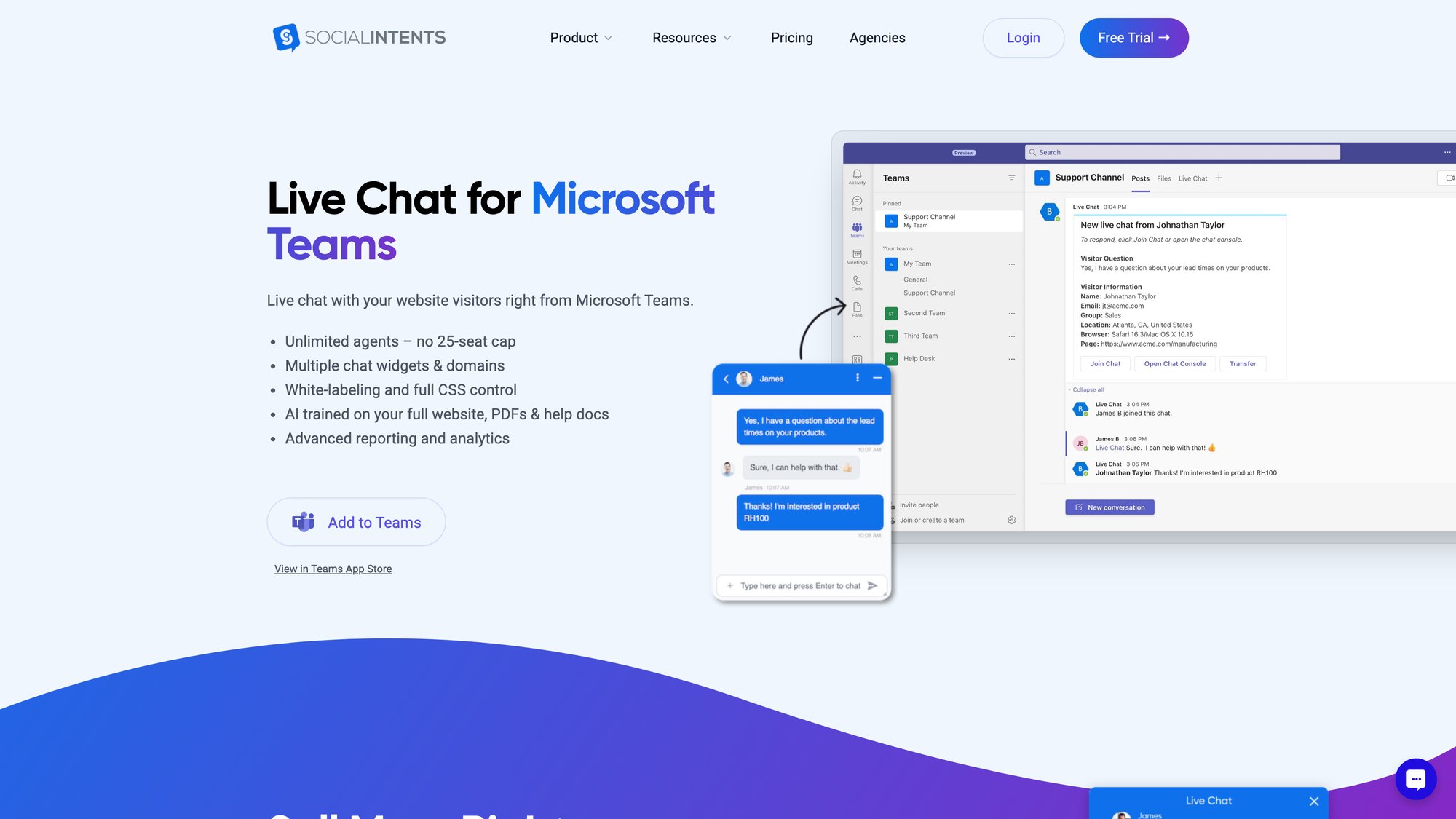
AI Chatbots with Human Handoff
We support AI chatbots powered by ChatGPT, Claude, and Gemini. Train them on your content, let them handle common questions, and they'll smoothly escalate to humans when needed. This gives you automation without losing the personal touch.
Plus, you can set up custom AI actions to integrate with third-party tools for things like order status, ticket creation, or shipping updates. Customers are increasingly interested in these enriched chat experiences.
WhatsApp and Messenger Support
Beyond website chat, we support WhatsApp chatbot and Facebook Messenger chatbots with escalation into your Teams or Slack workflow. Engage customers on the channels they prefer.
Affordable and Transparent Pricing
Our plans start at $39/month for small teams and scale based on conversation volume, not seats. No surprise charges, no complex add-ons to decipher.

| Plan | Price | Key Features |
|---|---|---|
| Starter | $39/mo | 1 widget, 3 agents max, 200 chats/mo, ChatGPT integration |
| Basic | $69/mo | 2 widgets, unlimited agents, 1,000 chats/mo, ChatGPT integration |
| Pro | $99/mo | 5 widgets, unlimited agents, 5,000 chats/mo, remove branding |
| Business | $199/mo | 10 widgets, unlimited agents, 10,000 chats/mo, real-time translation |
Our transparent pricing structure means no surprises. Each tier clearly shows what you get, and with unlimited agents starting at the Basic plan, you can scale your team without worrying about per-seat costs adding up.
Is Social Intents Right for You? When to Choose It Over Drift or Intercom
You're a Teams or Slack-first organization
If your team already lives in these tools, meeting them there (instead of forcing a new app) can dramatically improve response times and adoption.
You want live chat without complex infrastructure
We're not trying to be Intercom's full support suite or Drift's sales machine. We're focused on making chat simple, affordable, and integrated with where your team works.
Budget matters
Spending $30k/year on Drift or thousands per month on Intercom isn't realistic for many businesses. Our pricing is designed for small-to-mid-sized companies that want professional chat capabilities without enterprise costs.
You need both sales and support coverage
Since we don't charge per seat, you can have sales reps and support agents and product team members all able to answer chats. This flexibility is harder with seat-based pricing.
You run an e-commerce store
We have native integrations for Shopify live chat, BigCommerce live chat, Wix live chat, and WordPress live chat, making it easy to add customer support to your online store.
To be clear, Social Intents isn't a direct replacement for every Intercom or Drift feature. We don't have Intercom's full product tour capabilities or Drift's advanced ABM playbooks. But for many businesses, those aren't actually needed. What they need is responsive live chat, AI automation where it helps, and a system their team will actually use.
If you're curious whether this approach fits your workflow, try Social Intents free for 14 days.
Other Drift and Intercom Alternatives Worth Considering
Beyond Social Intents, there are several other tools in this space:
| Platform | Best For | Starting Price | Key Strength |
|---|---|---|---|
| HubSpot Chat | HubSpot CRM users | Free (with HubSpot) | Simple lead capture, tight CRM integration |
| Tidio | Small businesses | ~$19/mo | Affordable, basic chat and chatbot features |
| Freshchat | Support-focused teams | ~$15/agent/mo | More affordable than Intercom for support |
| Zendesk | Enterprise support | ~$55/agent/mo | Comprehensive helpdesk with chat add-on |
| HelpCrunch | Budget-conscious teams | ~$12/agent/mo | Chat + email + knowledge base at lower cost |
HubSpot Chat
Free if you use HubSpot CRM. Basic but functional for simple lead capture. Lacks the sophistication of Drift or Intercom. Social Intents integrates with HubSpot if you want more advanced chat capabilities while keeping your HubSpot CRM connection.
Tidio
Aimed at small businesses. Lower cost with basic chat and chatbot features. Good starter option.
Freshchat/Freshdesk
Traditional helpdesk with chat capabilities. More affordable than Intercom for support-focused teams.
Zendesk
Enterprise support giant adding more AI and conversational features. Complex pricing and may be overkill for smaller teams. Social Intents integrates with Zendesk if you want to keep your existing helpdesk while adding Teams/Slack chat capabilities.
HelpCrunch
Chat + email + knowledge base at lower cost than Intercom. Worth evaluating for support teams on tighter budgets.
The key is matching the tool to your actual needs rather than buying the one with the longest feature list.
Drift vs Intercom: Final Recommendations for 2025
Go with Drift if:
You're a B2B company with high-value deals where generating qualified pipeline is your top priority, you have a dedicated sales team ready to engage, and you can justify $30k+ annually based on expected ROI.
Go with Intercom if:
You're a SaaS or digital product company that needs comprehensive support infrastructure, values proactive user engagement and onboarding, and has budget to invest in a premium all-in-one platform.
Go with Social Intents if:
You're a Teams or Slack-first organization that wants simple, affordable live chat and AI chatbots without learning new software, prefers unlimited agents over per-seat pricing, and needs something that works for both sales and support without enterprise costs.
Consider other alternatives if:
Budget is extremely tight (look at HubSpot Free, Tidio), you need basic features and don't want to overpay (Freshdesk, HelpCrunch), or you have very specific requirements neither platform addresses perfectly.
Drift vs Intercom: Making Your Final Decision
Here's what matters most: Drift and Intercom are both excellent at what they were built to do. The question isn't which is "better" overall, but which is better for your specific situation.
Drift will generate more qualified sales pipeline if you have the team and budget to leverage it. Intercom will provide better customer support and engagement if you need comprehensive tools and can justify the investment.
And if both feel like overkill or don't quite fit your workflow, remember there are alternatives designed with different philosophies. We built Social Intents specifically for teams that want to stay in their existing tools rather than add another dashboard to monitor.
The best choice is the one your team will actually use effectively. Try out the platforms (most offer trials), see how they fit your workflow, and measure whether the value justifies the cost.
Whatever you choose, adding live chat and automation to your customer communication will improve engagement. It's just a matter of finding the right tool for your specific needs and budget in 2025.
Drift vs Intercom FAQs: Common Questions Answered
Which is better for small businesses, Drift or Intercom?
Intercom is typically better for small businesses because it has lower-cost entry plans (~$39/seat/mo) compared to Drift's $2,500/month minimum. But Intercom's costs can scale quickly with add-ons. For many small businesses, alternatives like Social Intents ($39-$69/mo with unlimited agents) or HubSpot's free chat offer more affordable options.
What's the main difference between Drift and Intercom?
Drift is built for sales and lead generation with features like meeting scheduling, lead qualification bots, and ABM targeting. Intercom is built for customer support and engagement with helpdesk functionality, knowledge base, in-app messaging, and product tours. Drift helps you get customers; Intercom helps you support them.
How much does Drift actually cost?
Drift's Premium plan starts around $2,500 per month (annual contract, so ~$30,000/year minimum). Advanced and Enterprise tiers require custom quotes and cost significantly more. Unlike Intercom, Drift doesn't publish detailed pricing publicly, requiring sales calls for exact quotes.
How much does Intercom actually cost?
Intercom uses seat-based pricing starting around $39-$99 per agent per month depending on tier. But you'll also pay for add-ons like Fin AI ($0.99 per resolution), Product Tours, and usage-based charges for contacts and messaging. Total monthly costs commonly reach $500-$1,500+ for mid-sized teams when including all components.
Can I use Drift for customer support?
Not really. Drift lacks essential support features like a ticketing system, knowledge base, and email workflow management. While you can route support chats to an inbox, there's no case tracking or SLA monitoring. Companies using Drift for sales typically use a separate tool (like Zendesk or Intercom) for support.
Can I use Intercom for sales?
Yes, but it's not optimized for it. Intercom can capture leads on your marketing site and sync them to your CRM. But it lacks Drift's sales-specific features like built-in calendar scheduling for meetings and advanced sales playbooks. For serious sales-driven chat, Drift or a dedicated sales tool works better.
Does Intercom or Drift integrate with Microsoft Teams?
Neither Intercom nor Drift offers native Teams integration where you can reply to chats directly from Teams. Both can send notifications to Teams when chats come in, but your team still needs to respond in the Intercom or Drift dashboard. If you want to answer website chats directly from Teams, Social Intents was built specifically for that workflow.
Can I answer chats from Slack with Drift or Intercom?
Both send notifications to Slack, but you can't reply from Slack. You'll see alerts when new chats arrive, but must switch to the Drift or Intercom interface to respond. Social Intents enables full two-way chat from Slack, letting your team answer website visitors without leaving Slack.
Which has better AI capabilities, Drift or Intercom?
Intercom's AI is more advanced for support. Fin (powered by GPT-4) can answer complex customer questions from your knowledge base and charges per resolution. Copilot suggests agent replies. Drift's AI focuses on sales, qualifying leads and routing conversations. For support automation, Intercom wins. For sales qualification, Drift wins. Social Intents offers AI chatbots powered by ChatGPT, Claude, and Gemini for businesses wanting affordable AI automation.
Is there a free alternative to Drift and Intercom?
HubSpot offers free live chat if you use HubSpot CRM (also free). It's basic but functional for simple lead capture. Tawk.to is another free option with more limited features. For most businesses, free tools lack the automation and integration needed for serious use, but they're worth trying if budget is extremely tight.
Do Drift and Intercom offer free trials?
Intercom offers a 14-day free trial (requires credit card for full functionality). Drift typically requires contacting sales rather than offering self-service trials. Social Intents offers a 14-day free trial with no credit card required.
Which is easier to set up, Drift or Intercom?
Intercom is generally quicker to get started. Add the chat widget snippet and you can start answering chats the same day. The complexity comes when configuring advanced automation. Drift requires more upfront setup because you'll design playbooks and integrate your CRM. Many Drift customers work with onboarding managers to configure everything properly.

